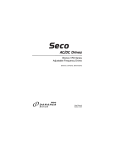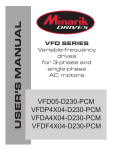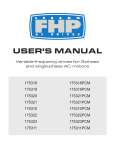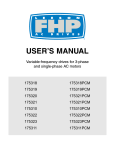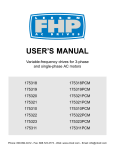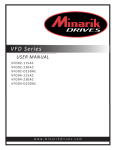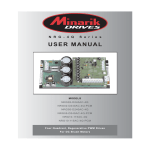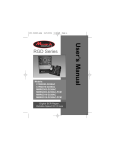Download User`s Manual - Minarik Drives
Transcript
User’s Manual MMVFD SERIES MODEL: MMVFD06-D230AC Variable-frequency drives for 3-phase AC motors Copyright 2002 by Ellis Manufacturing Company, Inc. All rights reserved. No part of this manual may be reproduced or transmitted in any form without written permission from Ellis. The information and technical data in this manual are subject to change without notice. Ellis Mfg. Co. and its Divisions make no warranty of any kind with respect to this material, including, but not limited to, the implied warranties of its merchantability and fitness for a given purpose. Ellis Mfg. Co. and its Divisions assume no responsibility for any errors that may appear in this manual and make no commitment to update or to keep current the information in this manual. Printed in the United States of America. i Safety Warnings • This symbol denotes an important safety tip or warning. SHOCK HAZARD AVOID HEAT KEE DR OID ATION Please read these instructions carefully before performing any of the procedures contained in this manual. • DO NOT INSTALL, REMOVE, OR REWIRE THIS EQUIPMENT WITH POWER APPLIED. Have a qualified electrical technician install, adjust and service this equipment. Follow the National Electrical Code and all other applicable electrical and safety codes, including the provisions of the Occupational Safety and Health Act (OSHA), when installing equipment. • Reduce the chance of an electrical fire, shock, or explosion by proper grounding, over-current protection, thermal protection, and enclosure. Follow sound maintenance procedures. It is possible for a drive to run at full speed as a result of a component failure. Ellis strongly recommends the installation of a master switch in the main power input to stop the drive in an emergency. Circuit potentials are at 115 VAC or 230 VAC above earth ground. Avoid direct contact with the printed circuit board or with circuit elements to prevent the risk of serious injury or fatality. Use a non-metallic screwdriver for adjusting the calibration trimpots. Use approved personal protective equipment and insulated tools if working on this drive with power applied. ii General Information The MotorMaster Variable Frequency Drive (MMVFD06-D230AC) Series are solid-state, ASIC-based, variable-frequency AC motor drives. With a 115 or 230 VAC, 50/60 Hz, single-phase input, MMVFDs are factory calibrated for an output of 1* to 60 Hz. They will operate any 1 HP or smaller, 115- or 208/230-volt, three-phaseAC-induction, single-phase or permanent split capacitor motor through a speed range of zero* through nameplate speed. They can be user calibrated for 1* through 115 Hz output. Although MMVFD inverters can operate over a 30:1 speed range, most AC motors will operate over a 10:1 speed range with constant torque at 1* to 60 Hz and constant horsepower above 60 Hz. (Inverter-duty motors may operate satisfactorily over a 20:1 speed range, while vector-duty motors may operate satisfactorily over a 30:1 speed range.) Some motors can be satisfactorily operated at speeds as low as 50 rpm (speed range 50:1). Below 50 rpm, some motors may show signs of “stepping” or “cogging”, or run warmer. * Although the MMVFD will allow a minimum of 1 Hz, the actual minimum frequency is dependent on motor type and load. The motor may need to be derated for lowfrequency (lower than 30 Hz) operation. Please consult the motor manufacturer if the operating frequency is lower than 30 Hz. General Information iii Many 3-phase inverter manufacturers claim that they can run single-phase motors effectively. This is normally accomplished by wiring only 2 phases; however, this primitive method may cause instabilities due to the lack of feedback from one of the motor connections. Furthermore, motor torque will be reduced considerably because the phases are still 120º apart. The MMVFD can efficiently operate a single-phase motor because the ASIC changes the phase shift to 180º in order to develop maximum torque. A 90º phase-shifted output is provided in two-phase operation in order to eliminate the start capacitor. The MMVFD series features solid-state reversing with adjustable acceleration and deceleration. The MMVFD may also interface with motor thermal protection through the enable circuit. iv General Information MMVFD Series Features • ASIC-based • Solid-state circuitry • Adjustable minimum and maximum speed • Adjustable acceleration and deceleration • Solid-state braking and reversing • Adjustable current limit • Adjustable V/Hz during acceleration • Adjustable voltage boost at low speeds • Multiple motor operation • Three-phase and single-phase motor control • Power LED • Current limit LED • DC injection braking General Information IMPORTANT INFORMATION Caution should be taken when operating fan-cooled motors at low speeds because their fans may not move sufficient air to properly cool the motor. Ellis ercommends “inverter-duty” motors when the speed range is beyond 10:1. In addition to standard 3-phase induction motors, the following motor types may be used with the MMVFD: • Permanent split capacitor (PSC) • Shaded pole • AC synchronous • AC stepping: 28.8, 72 and 200-RPM type. The following motor types MAY NOT be used: • Split phase • Capacitor start • Repulsion induction • Series Universal AC/DC • Any motor with starting switch (centrifugal or relay) and/or separate starting winding. v vi Contents Safety Warnings i General Information ii MMVFD Series Features . . . . . . . . . . . . . . . . . . . . . . . . . . . . . . . . . . . . . . . .iv IMPORTANT INFORMATION . . . . . . . . . . . . . . . . . . . . . . . . . . . . . . . . . . . . . .v Specifications 1 Dimensions 2 Installation 3 Mounting . . . . . . . . . . . . . . . . . . . . . . . . . . . . . . . . . . . . . . . . . . . . . . . . . . . . .3 Wiring . . . . . . . . . . . . . . . . . . . . . . . . . . . . . . . . . . . . . . . . . . . . . . . . . . . . . . .4 Shielding guidelines . . . . . . . . . . . . . . . . . . . . . . . . . . . . . . . . . . . . . . . . . .5 Heat sinking . . . . . . . . . . . . . . . . . . . . . . . . . . . . . . . . . . . . . . . . . . . . . . . . . .6 Fusing . . . . . . . . . . . . . . . . . . . . . . . . . . . . . . . . . . . . . . . . . . . . . . . . . . . . . .6 Connections . . . . . . . . . . . . . . . . . . . . . . . . . . . . . . . . . . . . . . . . . . . . . . . . . .6 Power connections . . . . . . . . . . . . . . . . . . . . . . . . . . . . . . . . . . . . . . . . . . .7 Motor connections . . . . . . . . . . . . . . . . . . . . . . . . . . . . . . . . . . . . . . . . . .11 Operation Voltage Input Warning 16 . . . . . . . . . . . . . . . . . . . . . . . . . . . . . . . . . . . . . . .16 Jumper Settings . . . . . . . . . . . . . . . . . . . . . . Drive phase output (JMP501 and JMP502) Acceleration mode select (JMP503) . . . . Braking mode select (JMP504) . . . . . . . . .. . .. .. . . . . . . . . . . . . . . . . . . . . . . . . . . . . . . . . . . . . . . . . . . . . . . . . . . . . . . . . . . . . . . . . . . .17 . . . . . . .17 . . . . . . .18 . . . . . . .19 Voltage doubler output . . . . . . . . . . . . . . . . . . . . . . . . . . . . . . . . . . . . . . . . . .23 Startup . . . . . . . . . . . . . . . . . . . . . . . . . . . . . . . . . . . . . . . . . . . . . . . . . . . . .24 To reverse motor direction: . . . . . . . . . . . . . . . . . . . . . . . . . . . . . . . . . . . .25 To stop the drive: . . . . . . . . . . . . . . . . . . . . . . . . . . . . . . . . . . . . . . . . . . .25 Calibration 26 Calibration Procedure . . . . . . . . . . . . . . . . . . . . . . . . . . . . . . . . . . . . . . . . . .28 vii MINIMUM SPEED (MIN) . MAXIMUM SPEED (MAX) BOOST . . . . . . . . . . . . . . TORQUE LIMIT (TQ LIM) . ACCELERATION (ACCEL) DECELERATION (DECEL) Troubleshooting . . . . . . . . . . . . . . . . . . . . . . . . . . . . . . . . . . . . . . . . . . . . . . . . . . . . . . . . . . . . . . . . . . . . . . . . . . . . . . . . . . . . . . . . . . . . . . . . . . . . . . . . . . . . . . . . . . . . . . . . . . . . . . . . .28 . . . . . . . . . . . . . . . . .28 . . . . . . . . . . . . . . . . .29 . . . . . . . . . . . . . . . . .29 . . . . . . . . . . . . . . . . .30 . . . . . . . . . . . . . . . . .30 31 Before troubleshooting . . . . . . . . . . . . . . . . . . . . . . . . . . . . . . . . . . . . . . . . .31 Diagnostic LEDs . . . . . . . . . . . . . . . . . . . . . . . . . . . . . . . . . . . . . . . . . . . . . .32 POWER . . . . . . . . . . . . . . . . . . . . . . . . . . . . . . . . . . . . . . . . . . . . . . . . . .32 TQ LIMIT . . . . . . . . . . . . . . . . . . . . . . . . . . . . . . . . . . . . . . . . . . . . . . . .32 Replacement Parts . . . . . . . . . . . . . . . . . . . . . . . . . . . . . . . . . . . . . . . . . . . .38 Tables Table 1. Jumper Settings . . . . . . . . . . . . . . . . . . . . . . . . . . . . . . . . . . . . . . . . .17 Table 2. Replacement Parts . . . . . . . . . . . . . . . . . . . . . . . . . . . . . . . . . . . . . . .38 viii Illustrations Figure 1. MMVFD06-D230AC Dimensions . . . . . . . . . . . . . . . . . . . . . . . . . . . . .2 Figure 2. AC Line Connection, No Voltage Doubler Used (115 VAC In, 115 VAC Out or 230 VAC In, 230 VAC Out) . . . . . . . . . . .8 Figure 3. AC Line Connection With Voltage Doubler (115 VAC In, 230 VAC Out) . . . . . . . . . . . . . . . . . . . . . . . . . . . . . . . .10 Figure 4. Motor Connections for Single-Phase Operation (Motor With Pre-Wired Capacitor) . . . . . . . . . . . . . . . . . . . . . . . . . . . .12 Figure 5. Motor Connections for Two-Phase Operation (No Pre-Wired Capacitor) . . . . . . . . . . . . . . . . . . . . . . . . . . . . . . . . . .14 Figure 6. Motor Connections for Three-Phase Motors . . . . . . . . . . . . . . . . . . . .15 Figure 7. MMVFD06-D230AC Braking Personality . . . . . . . . . . . . . . . . . . . . . . .20 Figure 8. MMVFD06-D230AC Acceleration Personality . . . . . . . . . . . . . . . . . . .20 Figure 9. Jumper Terminal Locations . . . . . . . . . . . . . . . . . . . . . . . . . . . . . . . . .21 Figure 10. Jumper Settings . . . . . . . . . . . . . . . . . . . . . . . . . . . . . . . . . . . . . . . .22 Figure 11. MMVFD06-D230AC Calibration Trimpot Layout . . . . . . . . . . . . . . . .27 Figure 12. Diagnostic LED location . . . . . . . . . . . . . . . . . . . . . . . . . . . . . . . . . .33 1 Specifications Drive 1-Phase Input (VAC) 1 or 3-Phase Output (VAC) Max HP MMVFD06-D230AC* 115/230 230 1 Max Continuous AC Output Amps Current (AC) In 6.0† 16/10 *Connect only 115 VAC line input to the 115 VAC terminals. Do not connect 230 VAC line input to the 115 VAC terminals. This will result in severe damage to the motor and drive, and possible explosion and injury. AC Voltage Input Range 115/230 VAC ± 10%, 50/60 Hz single phase Fundamental Carrier Frequency 15 KHz Output Frequency Range 1 – 120 Hz Adjustable Minimum Output Frequency Range 1** – 11 Hz Maximum Output Frequency Range (60 Hz output) 40–120 Hz Acceleration Time Range (no load) 2 seconds Deceleration Time Range (no load) 2 seconds Input Impedance Vibration ~ 50K ohms 0.5G max (20 – 50 Hz) 0.1G max (>50 Hz) Weight Ambient Operating Temperature Range 1.2 lb 10º – 55º C **The actual minimum frequency observed is a function of the motor and system. † Derate current by 2% per degree if the operating temperature is above 40º C. Under no circumstances may the ambient temperature exceed 55º C. 2 Dimensions 6.90 [175] 9.80 [249] 7.00 [178] 0.12 [3.05] 2.31 [58.7] 5.51 [140] 1.45 [36.8] 4.78 [121] 10.2 [259] 1.40 [35.0] 6.30 [160] 1.50 [38.1] 1.50 [38.1] ALL DIMENSIONS IN INCHES [MILLIMETERS] Figure 1. MMVFD06-D230AC Dimensions 3 Installation Mounting Warning Do not install, rewire, or remove this control with input power applied. Doing so may cause fire or serious injury. Make sure you have read and understood the Safety Warnings before attempting installation. NOTE: Horizontal mounting may require derating the drive. See your Ellis representative for more information. • Mount the drive in either a vertical plane (recommended) or the horizontal plane. Four 0.19-inch (5 mm) wide slots accept #8 pan head screw. Fasten either the large base or narrow flange of the chassis to the subplate. • Drive components are sensitive to electrostatic fields. Avoid direct contact with the circuit board. Hold drive by the chassis only. • Protect the drive from dirt, moisture, and accidental contact. • Provide sufficient room for access to the terminal block and calibration trimpots. • Mount the drive away from heat sources. Operate the drive within the specified ambient operating temperature range. • Prevent loose connections by avoiding excessive vibration of the drive. • The chassis must be earth grounded. Use a star washer beneath the head of at least one of the mounting screws to penetrate the anodized chassis surface and to reach bare metal. 4 Installation Wiring Warning Do not install, remove, or rewire this equipment with power applied. Failure to heed this warning may result in fire, explosion, or serious injury. Circuit potentials are at 115 or 230 VAC above ground. To prevent the risk of injury or fatality, avoid direct contact with the printed circuit board or with circuit elements. Do not disconnect any of the motor leads from the drive unless power is removed. Removing any one motor lead while the drive is running may destroy the drive. • Use 20-24 AWG wire for speed adjust potentiometer wiring. Use 14–16 AWG wire for AC line (L1, L2) and motor (U,V and W) wiring. Installation 5 Shielding guidelines Warning Under no circumstances should power and logic leads be bundled together. Induced voltage can cause unpredictable behavior any electronic device, including motor controls. As a general rule, Ellis recommends shielding of all conductors. If it is not practical to shield power conductors, Ellis recommends shielding all logic-level leads. If shielding the logic leads is not practical, the user should twist all logic leads with themselves to minimize induced noise. It may be necessary to earth ground the shielded cable. If noise is produced by devices other than the drive, ground the shield at the drive end. If noise is generated by a device on the drive, ground the shield at the end away from the drive. Do not ground both ends of the shield. If the drive continues to pick up noise after grounding the shield, it may be necessary to add AC line filtering devices, or to mount the drive in a less noisy environment. Logic wires from other input devices, such as motion controllers and PLL velocity controllers, must be separated from power lines in the same manner as the logic I/O on this drive. 6 Installation Heat sinking MMVFD06 series drives have sufficient heat sinking in their basic configurations. No additional heat sinking is necessary. Fusing MMVFD series drives are shipped with two 20-amp line fuses preinstalled. Refer to Replacement Parts (page 38) for replacement line fuse part numbers. Use fast-acting fuses rated for 250 volts, and approximately 150% - 200% of the maximum motor current. Connections Warning Do not connect this equipment with power applied. Failure to heed this directive may result in fire or serious injury. Do not connect the DOUBLER terminals if your line input voltage is 115 VAC and your desired output voltage is 115 VAC. Under no circumstances may the DOUBLER terminals be connected if your line voltage is 230 VAC. This may result in severe damage to the motor and drive, possible explosion and severe injury. Installation Power connections No voltage doubler used (115 VAC input, 115 VAC output, or 230 VAC input, 230 VAC output) Warning Do not connect the DOUBLER terminals if your line input voltage is 115 VAC and your desired output voltage is 115 VAC. Under no circumstances may the DOUBLER terminals be connected if your line voltage is 230 VAC. This may result in severe damage to the motor and drive, possible explosion and severe injury. If the voltage doubler is not used, connect the AC line voltage as follows: 1. Connect AC line voltage to LINE IN L1 and L2 terminals as shown in Figure 2 (page 8). 2. Locate the WHITE lead with a BLACK STRIPE. This lead is connected to the POWER switch on the front cover of the case. Connect this lead from the POWER switch to the L2/230 terminal on the printed circuit board. 7 8 Installation JMP504 C502 1 2 3 1-2 = COAST STOP 2-3 = BRAKE STOP POWER IC501 IL501 C505 C17 BR501 C508 TH502 TH501 T501 6 OM S1 S2 S3 SW1 FU502 L1 L2/240 DOUBLER FU501 L1 L2 L2/120 SW2 AC LINE VOLTAGE INPUT 115 VAC IN, 115 VAC OUT or 230 VAC IN, 230 VAC OUT BLACK ACK WITH W WHITE TE STR STRIPE WHITE HITE ITE W WITH BLACK ACK STRIPE ST Figure 2. AC Line Connection, No Voltage Doubler Used (115 VAC In, 115 VAC Out or 230 VAC In, 230 VAC Out) Installation 9 Voltage doubler output (115 VAC input, 230 VAC output) WARNING Do not connect the 230 VAC line input to the 115 VAC terminals. This will result in severe damage to the motor and drive, possible explosion, and severe injury. MMVFD-D230AC-series drives are equipped with a unique voltagedoubling feature, for use when 230 VAC input voltage is not available. This feature converts a 115 VAC input to a 230 VAC output, for use with 230V motors. The drive current output remains the same. Use caution when connecting this output. 1. Connect the AC line voltage leads to the LINE IN terminals as shown in Figure 3 (page 10). 2. Locate the WHITE lead with a BLACK STRIPE. This lead is connected to the POWER switch on the front cover of the case. Connect this lead to the L2/120 terminal on the printed circuit board. 3. Jumper the DOUBLER and L2/240 terminals as shown in Figure 3 (page 10). 10 Installation 5 W JMP504 C502 1 2 3 1-2 = COAST STOP 2-3 = BRAKE STOP POWER IC501 IL501 C505 C17 BR501 C508 TH502 TH501 T501 6 S2 S3 SW1 FU502 EV L1 L2/240 DOUBLER FU501 L1 L2 L2/120 SW2 AC LINE VOLTAGE INPUT DOUBLER MODE 115 VAC IN 230 VAC OUT BLACK ACK WITH W WHITE TE STR STRIPE WHITE HITE ITE W WITH BLACK ACK STRIPE ST Figure 3. AC Line Connection With Voltage Doubler (115 VAC In, 230 VAC Out) Installation 11 Motor connections Single-phase operation Warning It is very important that terminal V, the center motor terminal on the circuit board, be left open (no connection) for singlephase operation. NOTE: If the motor and capacitor are sold separately, Ellis highly recommends buying only the motor and operating in 2-phase mode as described below. The resulting speed range will be considerably wider, while starting torque will approach that of a 3-phase motor. If the motor capacitor is permanently mounted to the motor by the factory, Ellis recommends leaving the capacitor attached (thereby reducing the potential for human error) and running the drive and motor in single-phase mode. NOTE: Ensure that jumper terminals JMP501 and JMP502 are properly set before applying power to the motor and drive. Refer to Table 2 (page 17) for proper jumper settings. Connect the motor as shown in Figure 4 (page 12). Ensure that the prewired capacitor and its associated motor coil are connected to terminals U and W as shown. This connection may be internal if using a 2-wire motor. If the motor has three leads, the user must make this connection. 12 Installation N O T E C503 This connection may be internal to the motor (two wire leads). If not, (three wire leads) the user must make this connection. Q502 C510 Q501 U C501 Q504 C509 Q503 V C504 MOTOR WINDINGS Q506 C506 Q505 W PRE-WIRED START CAPACITOR C502 OAST STOP RAKE STOP POWER IC501 IL501 C505 BR501 C508 TH502 TH501 T501 Figure 4. Motor Connections for Single-Phase Operation (Motor With Pre-Wired Capacitor) Installation 13 Two-phase operation Warning For two-phase operation, ensure that the start capacitor is not connected. NOTE: Ensure that jumper terminals JMP501 and JMP502 are properly set before applying power to the motor and drive. Refer to Table 1 (page 17) for proper jumper settings. Connect the motor as shown in Figure 5 (page 14). Ensure that terminals U and V are connected through the motor coil as shown. In a three-wire motor, this connection may be internal. If the motor has four leads, you must make this connection yourself. Three-phase operation NOTE: Ensure that jumper terminals JMP501 and JMP502 are properly set before applying power to the motor and drive. Refer to Table 1 (page 17) for proper jumper settings. Connect a three-phase motor to terminals U, V and W as shown in Figure 6 (page 15). 14 Installation 503 Q502 C510 Q501 U C501 Q504 C509 Q503 V MOTOR WINDINGS C504 Q506 C506 Q505 W C502 504 COAST STOP BRAKE STOP POWER IC501 IL501 C505 C508 BR501 N O T E TH502 TH501 T501 This run capacitor MUST BE OMMITED for two-phase operation 6 SW1 FU502 LINE IN L1 L1 L2/240 FU501 L2 SW2 Figure 5. Motor Connections for Two-Phase Operation (No Pre-Wired Capacitor) Installation 15 Q502 C510 Q501 U C501 Q504 C509 Q503 V C504 MOTOR WINDINGS Q506 C506 Q505 W C502 504 = COAST STOP = BRAKE STOP POWER IC501 IL501 C505 BR501 C508 TH502 TH501 T501 6 SW1 FU502 LINE IN L1 L1 L2/240 FU501 L2 SW2 Figure 6. Motor Connections for Three-Phase Motors 16 Operation Warning Dangerous voltages exist on the drive when it is powered, and up to 60 seconds after power is removed and the motor stops. BE ALERT. High voltages can cause serious or fatal injury. For your safety, use personal protective equipment (PPE) when operating this drive. Do not change jumper settings with power applied. Ensure that jumper settings are compatible with the motor being controlled. Voltage Input Warning Do not connect 230 VAC line input to the 115 VAC terminals. This will result in severe damage to the motor and drive, and possible explosion and injury. Under no circumstances may the DOUBLER terminals be connected when the AC line voltage is 230 VAC. This will result in severe damage to the motor and drive, possible explosion and injury. Operation 17 Jumper Settings The MMVFD series is equipped with four jumper terminals, which control different aspects of drive operation. Refer to Figure 9 (page 21) for terminal locations. Drive phase output (JMP501 and JMP502) JMP501 and JMP502 must be set to match the phase of the motor being controlled. The factory (default) setting is three-phase operation (terminals 1 and 2 jumpered). Refer to Table 2 for optional jumper settings, or refer to Figure 10 on page 22. Table 1. Jumper Settings Motor Operation JMP501 Settings JMP502 Settings Single-phase 2-3 2-3 Two-phase 2-3 1-2 Three-phase 1-2 1-2 18 Operation Acceleration mode select (JMP503) The MMVFD-D230AC series is equipped with a dual V/Hz feature, which allows the setting of a linear or variable V/Hz characteristic. The linear setting should be used for all constant torque applications. The use of the variable characteristic in the appropriate applications can save energy at speeds below the base motor speed. Figure 8 (page 20) shows a simple graph illustrating the difference between linear- and variable-V/Hz modes. Linear acceleration mode produces a constant V/Hz and torque (current) output from the drive. In contrast, variable-torque mode produces a variable V/Hz and torque (current) output from the drive. As a result, fans and centrifugal pumps, which normally dissipate energy at low speeds, can be much more efficient. For linear-torque mode, jumper terminals 1 and 2 of JMP503 (this is the factory setting). For variable-torque mode, jumper terminals 2 and 3. Refer to Figure 7 (page 21) for terminal locations. Refer to Figure 10 (page 22) for jumper settings. Operation 19 Braking mode select (JMP504) The MMVFD series is equipped with DC injection braking, for use with high-inertia applications (see Figure 7, page 20). As a rule, DC motors do not convert AC ripple in the DC signal to mechanical energy; instead, it is dissipated as waste heat. AC motors perform in the opposite fashion: any DC component of an AC signal is converted to mechanical energy and acts as drag on an AC motor. Because DC voltage induces a “steady-state” magnetic field through the motor windings, the poles of the stator and rotor will tend to align themselves magnetically. Thus, the motor will not only slow down, but stop completely if the DC voltage is great enough. When injection braking is selected and the drive is disabled, the normal AC phase output to the motor from the drive is set to its minimum frequency. The drive simultaneously introduces a DC voltage (not to exceed the threshold set by the CURRENT LIMIT trimpot) into the motor stator for two (2) seconds. The motor will brake for two seconds, then coast to a stop. This stops the motor much more quickly and efficiently than simply coasting to a stop, while avoiding high currents which may damage the motor and drive. For normal operation, jumper terminals 1 and 2 of terminal JMP504 (this is the factory setting). To enable DC injection braking, jumper terminals 2 and 3. Refer to Figure 10 (page 22) for terminal locations. 20 Operation STOPPING WITH D C I N J ECTION BRAKING STOPPING WITHOUT D C INJ ECTION BRAKING MOTOR SPEED * NOTE: NOT DRAWN TO SCALE TIME Figure 7. MMVFD06-D230AC Braking Personality MOTOR SPEED CONSTANT TORQUE VARIABL E TORQUE * NOTE: NOT DRAWN TO SCALE TIME Figure 8. MMVFD06-D230AC Acceleration Personality 21 Operation C503 TQ LIMIT Q502 IL502 C510 1 2 3 JMP501 1-2 = 3 PHASE 2-3 = 1/2 PHASE Q501 JMP501 C14 U C501 Q504 JMP502 1 2 3 JMP502 C509 1-2 = 2/3 PHASE 2-3 = 1 PHASE Q503 JMP503 V V/HZ C504 1 2 3 JMP503 2-3 = PUMP/FAN C506 JMP504 Q506 BOOST ACCEL Q505 W DECEL JMP504 3 2-3 = BRAKE STOP MIN C502 1 POWER IC501 IL501 C505 C17 MAX BR501 C508 TH502 TH501 T501 TB501 1 6 ENABLE COM S1 S2 S3 SW1 FU502 FWD/REV L2/240 L2/120 LINE IN L1 L1 FU501 L2 Figure 9. Jumper Terminal Locations SW2 22 Operation MOTOR PHASE JUMPER SETTINGS (JMP501 AND JMP502) JMP501 SINGLE-PHASE MOTOR WITHOUT PREWIRED RUN CAPACITOR (2-PHASE OPERATION) SINGLE-PHASE MOTOR WITH PREWIRED RUN CAPACITOR THREE-PHASE MOTOR JMP502 JMP501 JMP502 JMP501 JMP502 1 1 1 1 1 1 2 2 2 2 2 2 3 3 3 3 3 3 ACCEL/TORQUE SETTINGS (JMP503) JMP503 BRAKING SETTINGS (JMP504) JMP503 JMP504 JMP504 1 1 1 1 2 2 2 2 3 3 Standard Operation 3 3 Pump/ Fan Normal Break Figure 10. Jumper Settings Operation 23 Voltage doubler output WARNING Do not connect the 230 VAC line input to the 115 VAC terminals. This will result in severe damage to the motor and drive, possible explosion, and severe injury. MMVFD06-D230AC-series drives are equipped with a unique voltage-doubling feature, for use when 230 VAC input voltage is not available. This feature converts a 115 VAC input to a 230 VAC output, for use with 230V motors. The drive current output remains the same. Refer to Figure 3 (page 10) for connection information. Use extreme caution when connecting this feature. Incorrect use of this feature may result in fire and serious injury. 24 Operation Startup Warning Do not change jumper settings with power applied. Ensure that jumper settings are compatible with the motor being controlled. 1. Verify that no conductive material is present on the PCB. 2. Verify that the correct voltage is connected to the inputs before applying power. DO NOT CONNECT 230 VAC POWER TO A 115 VAC DRIVE. Applying power in this manner will damage the motor and drive. 3. Verify that jumpers are set to the correct phasing for the motor under load. 4. Set the speed adjust knob to zero (full CCW). 5. Set the FWD-BRAKE-REV switch to the desired direction. 6. Apply 115 or 230 VAC, 50/60 Hz, single-phase power to the drive. The green POWER LED will come on after an initial delay of 1- 2 seconds, in which all logic circuits are checked for proper function. If it does not, check the external line fuses to ensure that they are properly installed and not blown. Operation 25 7. If you attempt to start and the red TQ LIMIT LED comes on, the control has entered torque limit mode. To avoid this occurrence, you may: a. increase the torque limit setting*, or b. lengthen the acceleration time enough to accommodate the needed starting torque by adjusting the ACCEL trimpot. To reverse motor direction: To reverse the direction of motor shaft rotation while the motor is running, set the FWD-BRAKE-REV switch to the desired direction. When a new direction is selected, there is no need to set the FWDBRAKE-REV switch to BRAKE. The control will automatically decelerate the motor down to zero speed and then reverse direction, accelerating and decelerating at a rate controlled by the ACCEL/DECEL trimpot setting. To stop the drive: Set the FWD-BRAKE-REV switch to BRAKE. The drive willl brake to a stop at a rate controlled by the TQ LIMIT trimpot setting. * Do not set the torque limit setting above 150% of the motor’s nameplate current rating. 26 Calibration Warning Dangerous voltages exist on the drive when it is powered, and up to 60 seconds after power is removed and the motor stops. When possible, disconnect the voltage input from the drive before adjusting the trimpots. If the trimpots must be adjusted with power applied, use insulated tools and the appropriate personal protection equipment. BE ALERT. High voltages can cause serious or fatal injury. The MMVFD series has seven user-adjustable trimpots. Each drive is factory calibrated to its maximum current rating. Readjust the calibration trimpot settings to accommodate lower horsepower motors. See Figure 11 for trimpot location. All adjustments increase with CW rotation and decrease with CCW rotation. Use a non-metallic screwdriver for calibration. Each trimpot is identified on the printed circuit board. 27 Calibration TQ LIMIT Q502 IL502 TORQUE LIMIT C510 1 2 3 JMP501 Q501 1-2 = 3 PHASE 2-3 = 1/2 PHASE C14 U Q504 JMP502 1-2 = 2/3 PHASE C509 1 2 3 2-3 = 1 PHASE Q503 V V/HZ 1 2 3 V/HZ JMP503 2-3 = PUMP/FAN Q506 BOOST BOOST C506 ACCEL Q505 ACCELERATION W DECEL DECELERATION 1 JMP504 3 2-3 = BRAKE STOP POWER MIN IL501 C17 MIN SPEED MAX C508 MAX SPEED T501 TB501 Figure 11. MMVFD06-D230AC Calibration Trimpot Layout 28 Calibration Calibration Procedure 1. Set the FWD-BRAKE-REV switch on the front cover to the BRAKE position. 2. Set all trimpots except BOOST, TQ LIM and V/HZ fully counterclockwise (CCW). 3. Set the TQ LIM trimpot to maximum (full CW). 4. Set the V/Hz trimpot to center of travel (12 o’clock position). 5. Make no adjustment to the BOOST trimpot. 6. Set JMP501 & JMP502 to 1 - 2 position (3-phase output). 7. Set the speed adjust pot to zero (full CCW). 8. Set the FWD-BRAKE-REV switch on the front cover to the desired direction. 9. Set the POWER switch to ON. 10. Calibrate the trimpots as follows: MINIMUM SPEED (MIN) 1. Set the speed adjust potentiometer to zero (full CCW). 2. Slowly rotate the MIN trimpot CW until the motor begins to turn, then slowly rotate the pot CCW until the motor just stops. This step calibrates the MIN SPD pot to zero speed without hysteresis. MAXIMUM SPEED (MAX) 1. Set the speed adjust potentiometer to maximum speed. 2. Using a hand-held tachometer or analog frequency meter as a reference, adjust the MAX trimpot until the desired speed or frequency is reached. Calibration 29 TORQUE LIMIT (TQ LIM) Warning Although the TQ LIM trimpot can be set up to 120% of the drive nameplate rating, continuous operation beyond the drive nameplate rating may cause damage to the motor and/or drive. 1. With no power applied to the drive, connect an ammeter in series with the motor. 2. Set the TQ LIM trimpot to full CCW. 3. Carefully lock the motor shaft. Ensure that the motor is firmly mounted. 4. Apply line power. The motor should be stopped. 5. Set the speed adjust potentiometer to maximum speed. The motor should remain stopped. 6. Slowly rotate the TQ LIM trimpot clockwise (CW) until the ammeter reads 120% of maximum motor current. 7. Set the speed adjust potentiometer to zero speed. 8. Remove power from the drive. 9. Remove the lock from the motor shaft. 10. Remove the ammeter in series with the motor. BOOST The boost trimpot is used to increase motor torque at low speeds. The minimum setting is sufficient for most applications and does not need to be adjusted. 30 Calibration If the motor runs rough or noisily at low speeds, the boost trimpot may need adjustment. Contact your Ellis representative for assistance. ACCELERATION (ACCEL) 1. Set the speed adjust potentiometer to minimum (full CCW) and wait for the motor to come to stop (or minimum speed). 2. Quickly set the speed adjust potentiometer to maximum speed (full CW) and note the time the motor takes to accelerate to maximum speed. 3. If the acceleration time differs from the desired time, adjust the ACCEL trimpot until the desired time is reached. Rotating the ACCEL pot CW slows acceleration, thereby increasing the ramp time DECELERATION (DECEL) 1. Set the speed adjust potentiometer to maximum (full CW) and wait for the motor to come to maximum speed. 2. Quickly set the speed adjust potentiometer to minimum speed (full CCW) and note the time the motor takes to decelerate to minimum speed. 3. If the deceleration time differs from the desired time, adjust the DECEL trimpot until the desired time is reached. Rotating the DECEL pot CW slows deceleration, thereby increasing the ramp time. 31 Troubleshooting Warning Dangerous voltages exist on the drive when it is powered, and up to 60 seconds after power is removed and the motor stops. When possible, disconnect the voltage input from the drive while troubleshooting. BE ALERT. High voltages can cause serious or fatal injury. Before troubleshooting Perform the following steps before starting any procedure in this section: • Disconnect AC voltage input from the drive. Wait 60 seconds for power to discharge. The green POWER LED will blink while power is discharging. • Check the drive closely for damaged components. • Check that no wire, chips, or other foreign material has become lodged on the printed circuit board. • Verify that every connection is correct and in good condition. • Verify that there are no short circuits or grounded connections. • Check that the drive’s rated phase current and RMS voltage are consistent with the motor ratings. For additional assistance, contact your local Ellis distributor, or the factory direct by telephone at: 1-800-ELLIS (646-2745). 32 Troubleshooting Diagnostic LEDs Ellis’s MMVFD series is equipped with diagnostic LEDS to assist the user in troubleshooting and monitoring equipment status while in use. Refer to Figure 12 for diagnostic LED locations. POWER The green POWER LED lights when AC line voltage is applied and the control’s low-voltage power supply is operational. TQ LIMIT The red TORQUE LIMIT LED lights when the drive output current exceeds the threshold set by the TQ LIMIT trimpot. If this LED lights, shut down the motor and drive by the disabling method or by removing power. Check the motor to make sure it is not jammed or overloaded. The TQ LIMIT trimpot may need to be recalibrated. See the Calibration section (page 26) for information on calibrating the TQ LIMIT trimpot. 33 Troubleshooting TQ LIMIT Q502 IL502 JMP501 Q501 1-2 = 3 PHASE 2-3 = 1/2 PHASE U C14 TORQUE LIMIT LED C510 1 2 3 Q504 JMP502 1-2 = 2/3 PHASE C509 1 2 3 2-3 = 1 PHASE Q503 V V/HZ 1 2 3 JMP503 2-3 = PUMP/FAN C506 POWER LED Q506 BOOST ACCEL Q505 W DECEL D 1 JMP504 3 2-3 = BRAKE STOP POWER MIN IL501 C17 MAX C508 T501 TB501 1 6 Figure 12. Diagnostic LED location 34 Troubleshooting Problem Line fuse blows Line fuse does not blow, but the motor does not run Possible Cause Suggested Solution 1. Line fuses are the wrong size. 1. Check that line fuses are properly sized for the motor being used. 2. Motor or motor cable is shorted to ground. 2. Check motor cable and motor for shorts. 3. Nuisance tripping caused by a combination of ambient conditions and high-current spikes (i.e. reversing). 3. Add a blower to cool the drive components; increase TQ LIM settings (page 29). 1. Speed adjust pot or voltage input signal is set to zero speed. 1. Increase the speed adjust pot setting or voltage input signal. 2. Speed adjust pot or voltage input signal is not properly connected to drive input; connections are open. 3. Drive is “tripped” off or has gone into thermal overload. 2. Check connections to input. Verify that connections are not open. 3. Disable, then reenable the drive. Troubleshooting Problem Possible Cause 35 Suggested Solution 4. Drive has been disabled. 4. Ensure that EN and COM terminals are properly connected. 5. Drive is in current limit. 5. Verify that motor is not jammed. Increase TQ LIM setting if it is set too low (page 29). 6. Drive is not receiving AC voltage input. 6. Apply AC line voltage to L1 and L2. 7. Motor is not connected. 7. Connect motor to drive outputs U, V and W. Motor runs too slow or too fast at set speed 1. MIN and MAX SPD are not calibrated. 1. Calibrate MIN and MAX SPD trimpots (page 28). Motor will not reach the desired speed 1. MAX SPD setting is too low. 1. Increase MAX SPD setting (page 28). 2. Nominal input voltage may be too low for motor. 2. Compare motor voltage to input voltage; replace motor if necessary. Line fuse does not blow, but the motor does not run (cont.) 36 Troubleshooting Problem Possible Cause Suggested Solution Motor will not reach the desired speed (cont.) 3. Motor is overloaded. 3. Check motor load. Resize the motor or drive if necessary. Motor pulsates or surges under load 1. Motor “bouncing” in and out of torque limit. 1. Make sure motor is not undersized for load; adjust TQ LIM setting CW (page 29). Motor does not reverse 1. Bad FWD-BRAKEREV switch connection. 1. Check FWDBRAKE-REV switch connection. 2. Reversing circuit not working properly. 2. Check reversing circuit by shorting DIR terminal to COM terminal with jumper wire. Troubleshooting Problem TQ is unsatisfactory at high speeds. Possible Cause 37 Suggested Solution 1. TQ LIMIT set too low. 1. Check TQ LIM setting (page 29). 2. TQ BOOST set too low. 2. Check TQ BOOST setting (page 29). 3. Load may exceed rating of motor/drive. 3. “Fix” load (i.e., straighten mounting, coupling, etc.); or replace motor and drive with motor and drive rated for higher horsepower. 4. Nominal input voltage may be too low for motor. 4. Compare motor voltage to input voltage. Replace motor if necessary. 38 Troubleshooting Replacement Parts Replacement parts are available from Ellis Corporation and its distributors for this drive series. Table 2. Replacement Parts Model No. Symbol Description Ellis P/N MMVFD06-D230AC C501-504 2200 uF, 25 VDC Capacitor 011-0140 FU501-502 20A 3AB Normal-blow Fuse 050-0019 Q501-Q506 IGBT 070-0086 TH501-502 20-amp Thermistor 033-0013 TB501 6-pin Wago Terminal Block 160-0163 39 Notes 40 Notes 107 W. Railroad Street PO Box 930219 Verona, WI 53593-0219 (800) 383-5547 Doc # 250-0317, Revision 1 - 4/01 Printed in the U.S.A





















































